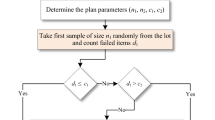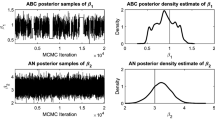Abstract
In this paper, and based on a hybrid censored sample from a Rayleigh distribution, Bayes estimators and highest posterior density credible intervals are obtained for the unknown parameter, and some lifetime parameters such as the reliability and hazard rate functions. Bayes estimators are obtained using squared error and linear–exponential loss functions. We also obtain the Bayes predictive estimator and %95 prediction interval for future observations. Finally, a numerical example is given to illustrate the application of the results and Monte Carlo simulations are performed to compare the performances of the different methods.
Similar content being viewed by others
References
Ahmadi J, Doostparast M, Parsian A (2005) Estimation and prediction in a two parameter exponential distribution based on k-record values under LINEX loss function. Commun Stat Theory Methods 34:795–805
Asgharzadeh A, Fallah A (2011) Estimation and prediction for exponentiated family of distributions based on records. Commun Stat Theory Methods 40:68–83
Balakrishnan N, Kundu D (2013) Hybrid censoring: models, inferential results and applications. Comput Stat Data Anal 57:166–209
Basu AP, Ebrahimi N (1991) Bayesian approach to life testing and reliability estimation using asymmetric loss function. J Stat Plan Inference 29:21–31
Bernardo JM, Smith AFM (1994) Bayesian theory. Wiley, New York
Chen S, Bhattachacharya GK (1988) Exact confidence bounds for an exponential parameter under hybrid censoring. Commun Stat Theory Methods 17:1857–1870
Childs A, Chandrasekhar B, Balakrishnan N, Kundu D (2003) Exact likelihood inference based on type-I and type-II hybrid censored samples from the exponential distribution. Ann Inst Stat Math 55:319–330
Draper N, Guttman I (1987) Bayesian analysis of hybrid life tests with exponential failure times. Ann Inst Stat Math 39:219–225
Ebrahimi N (1986) Estimating the parameter of an exponential distribution from hybrid life test. J Stat Plan Inference 14:255–261
Epstein B (1954) Truncated life tests in the exponentioal case. Ann Stat 25:555–564
Fernandez AJ (2000) Bayesian inference from type II doubly censored Rayleigh data. Stat Probab Lett 48:393–399
Feynman RP (1987) Mr. Feynman goes to Washington. Engineering and Science. California Institute of Technology, Pasadena
Gupta DR, Kundu D (1998) Hybrid censoring schemes with exponential failure distribution. Commun Stat Theory Methods 27:3065–3083
Howlader HA, Hossain A (1995) On Bayesian estimation and prediction from Rayleigh based on type II censored data. Commun Stat Theory Methods 24:2249–2259
Jeong HS, Park JI, Yum BJ (1996) Development of \((r, T)\) hybrid sampling plans for exponential lifetime distributions. J Appl Stat 23:601–607
Kundu D, Joarder A (2006) Analysis of Type-II progressively hybrid censored data. Comput Stat Data Anal 50:2509–2528
Kundu D, Pradhan B (2009) Estimating the parameters of the generalized exponential distribution in presence of hybrid censoring. Commun Stat Theory Methods 38:2030–2041
Lawless JF (1982) Stat models methods for lifetime data. Wiley, New York
Lin CT, Ng HKT, Chan PS (2009) Statistical inference of Type-II progressively hybrid censored data with Weibull lifetimes. Commun Stat Theory Methods 38:1710–1729
Ng HKT, Kundu D, Chan PS (2009) Statistical analysis of exponential lifetimes under an adaptive hybrid Type-II progressive censoring scheme. Nav Res Logist 56:687–698
Polovko AM (1986) Fundamentals of reliability theory. Academic Press, New York
Raqab MZ, Madi MT (2002) Bayesian prediction of the total time on test using doubly censored Rayleigh data. J Stat Comput Simul 72:781–789
Ren C, Sun D, Dey DK (2006) Bayesian and frequentist estimations and prediction for exponential distributions. J Stat Plan Inference 13:2873–2897
Soliman AA, Al-Aboud FM (2008) Baysian inference using record values from Rayleigh model with application. Eur J Oper Res 185:252–272
Wu S, Chen D, Chen S (2006) Baysian inference for Rayleigh distribution under progressive censored sample. Appl Stoch Models Bus Ind 26:126–279
Varian HR (1975) A Bayesian approach to real estate assessment. In: Finberg SE, Zellner A (eds) Studies in Bayesian econometrics and statistics in honor of Leonard J. Sarage. North Holland, Amsterdam, pp 195–208
Zellner A (1986) Bayesian estimation and prediction using asymmetric loss function. J Am Stat Assoc 81:446–451
Author information
Authors and Affiliations
Corresponding author
Appendix
Appendix
Here we discuss the unimodality condition for the posterior density of \(\theta \) given data. By considering the square root inverted gamma as a prior distribution for \(\theta \), the posterior density of \(\theta \) given data is
We have \(\pi (0\mid \underline{x})=\pi (\infty \mid \underline{x})=0\). To show that \(\pi (\theta \mid \underline{x})\) is unimodal, it is enough to show it is log concave. We have
and
So, the unimodality condition is summarized to \(\frac{d^{2} }{d \theta ^{2} } log \pi (\theta \mid \underline{x})\le 0\), or
Therefore, when this condition achieves, we can calculate the HPD credible intervals.
Rights and permissions
About this article
Cite this article
Asgharzadeh, A., Azizpour, M. Bayesian inference for Rayleigh distribution under hybrid censoring. Int J Syst Assur Eng Manag 7, 239–249 (2016). https://doi.org/10.1007/s13198-014-0313-7
Received:
Published:
Issue Date:
DOI: https://doi.org/10.1007/s13198-014-0313-7




